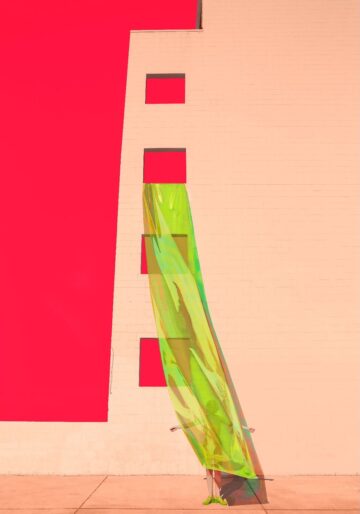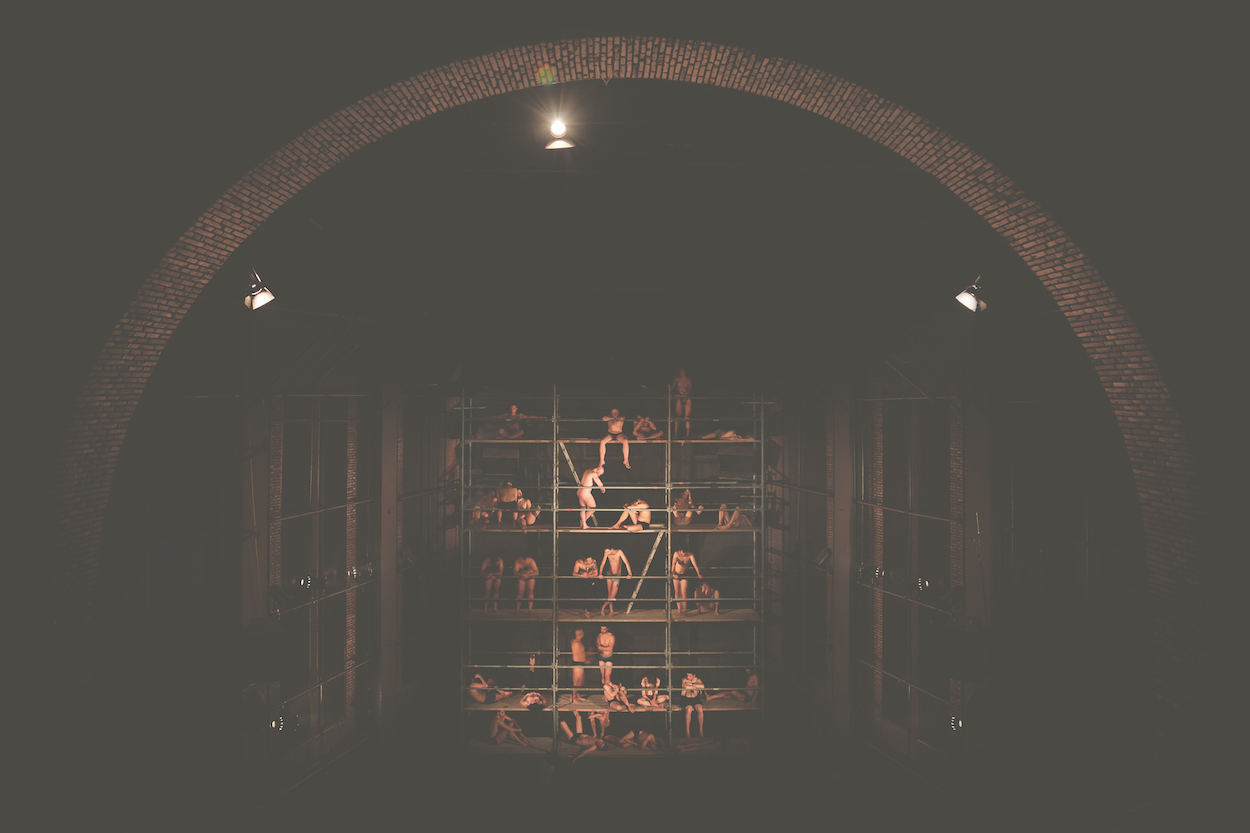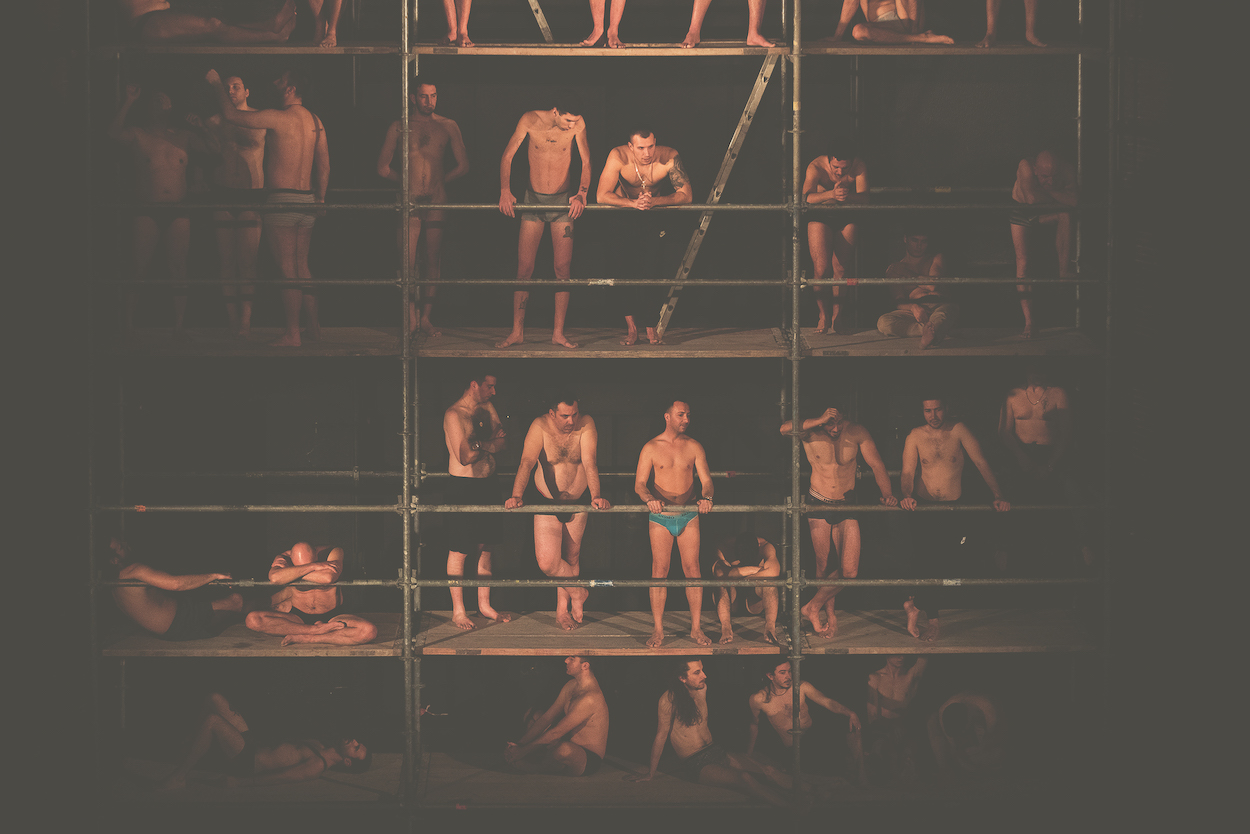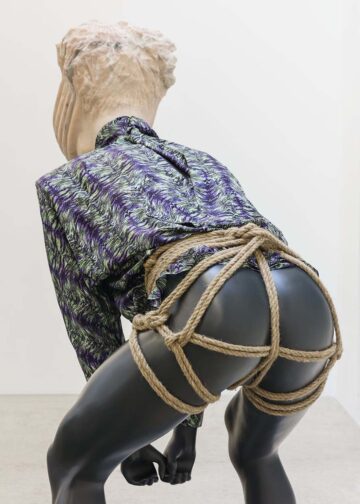
REINE PARADIS: “ECLIPSE” AT KÖNIG GALERIE
LA-based artist Reine Paradis will soon be coming to Berlin to present her newest body of…
All images courtesy of the artist


Renate Bertlmann is an Austrian artist who explored the social role of women and eroticism, sex, and religion in her works from the 1970s onwards.
Her exhibition Fragile Obsessions at Belvedere 21 (29 Sept – 3 March 2024) shows how her feminist art has been critically questioning and opposing not only gender and sexual norms, but also more abstract Western cultural norms like religion. One of the shown series of works is “Tender Christ,” the crucifixion sculpture that came to the Academy of Fine Arts in Vienna to be restored, to which the artist secretly added a crown of latex pacifiers and photographed it. It confronts two taboos: religion and sexuality. While it is by itself a controversial act to add a phallus-like object to the body of Christ, she addresses the power of Christ – meaning the religion, the Church, norms, and influence it has on sexuality. Religion always had the ambition to control, especially female, sexuality. So, feminist art since the 70s has been addressing this issue in various ways. The “Relict of Holy Erectus” was exhibited at Frieze as an installation comprising of a photo and offering box which is a penis represented as a relict: It points to the privileging of the phallus in our society as well as the exclusion of the body in the Church and the female from the concept of the Christian God. Seeing the Bertlmann show and seeing the connections between religion and sexuality in early feminist art made me think that the approach to religion and sexuality or eroticism in art is still kind of polarized between feminist criticism of the norm and feminist reinterpretation of religion as emancipatory.
Connections of sexuality and spirituality are not new in art history; even if we don’t go back to antiquity, the Christian era emphasized the physical with numerous gothic crucifixions, not to mention the Baroque period and its most representative work, “Saint Theresa in Ecstasy.” The art of the 20th century had a critical character, exposing religion to irony and subversion. An example is Kaucyila Brooke’s three-part, photomontage photo-novella “Tit for Twat” (1992-today), which criticizes the religious canon for its privileging of heterosexuality. It takes the taunt heard in the early 90s that if God had wanted homosexuality, it would have been Adam and Steve, and explores the implications of changes to the origin story. Imagine, the Garden of Eden would have been the site of much confusion about human nature and the nature of human sexuality. This reading questions the privileging of universalized systems of knowledge over decentralized narratives of difference.
On the other hand, New Age spirituality brought somewhat different approaches to religion and sexuality seen in the art of artists like Ana Mendieta, whose feminism relied on female connection with nature and spirituality, which departs from traditional Christian religion to more indigenous religious practices. It was an emancipatory use of spirituality that brought sexuality back to the realm of nature, seeing the archetype of Nature as the Great Goddess. This divine femininity is opposed to the Christian idea of the body as a source of sin.
Then, there was an attempt to borrow symbols from religion and give them new meaning, like the representation of Saint Sebastian, which during the second half of the 20th century, became a part of gay iconography. Here lays what I think contemporary art still mostly cares about: identification. Religion became just any other tradition, a source of inspiration for understanding the personal. Sexuality became so profane that it needed to be connected to the sacral again to give it meaning. This kind of identification involves suffering. The growing popularity of saints like Hildegard von Bingen comes from the need to imagine an alternative reality, where the emptiness of the mundane and banal is overcome by attributing a higher value to everyday suffering. Herein lays the fascination with contemporary martyrdom. While gay men found their own young and hot ideal in St. Sebastian, feminist art seems to approach things with a more layered interpretation.
The video performance of Anastasija Pavić, a young rising star of the Serbian art scene, called “Vanilla Salvation” (on view at the Queer Museum Vienna till 2.2.24) brought up the question of the complexity of new female archetypes. The work deals with the notions of salvation through the suffering of the stereotypical “sad girl.” Both salvation and suffering take the forms of widely discussed contemporary phenomena, such as eating disorders, toxic relationships, self-objectification, and modern spirituality. Sexuality and religion are again connected through the act of sacrifice. Mystical experience seems to stem from the experience of religious sacrifice and physical and emotional suffering. An eating disorder is likened to a toxic relationship in the video, and a sharp pain in the stomach is connected to psychosomatic pain caused by emotional distress. High levels of control – the video shows control over aestheticized femininity, and the deliberate expression of sexuality to be looked at, awareness of being an object of male desire – cause internalized struggles with the self, manifested in psychosomatic issues. Reference to Rosemary’s Baby is not accidental here; a woman is shown as transformed from expressing feminine tenderness, submissiveness and shyness (reference also to Virgin Mary and Mary Magdalene), an even baby-like personality, to an androgynous, hysterical and possessed person, the Demon Goddess.
Suffering is, in a religious discourse, a part of the fate of women, to live and reproduce in pain, here elaborated to the whole new identity of the woman who willingly suffers for love and femininity. Pain is interwoven into the idea of love itself (and every love is a vague copy of God’s love): “She is tired of wanting that rib-crushing love” or “Hug her so hard she can finally explode.” Why would she choose to be an object and sacrifice herself? Because it brings her a form of agency, she is not a passive object, she is an active subject who chooses objectification. And it brings control. The moment she puts on lipstick, she becomes untouchable. Sexuality as a masochistic practice can bring back agency, through controlling the desires of Others and making them want it. By being baby-like, she needs to be taken care of.
On the other hand, religion is a form of control of the body, mind and soul, by ultimately giving yourself to God, i.e. complete loss of control. Suffering is seen as something to be done religiously, perfectly done as hair, nails, or the sexual act:
“SHE HEARD SOMEWHERE THAT SUFFERING FEELS RELIGIOUS IF YOU DO IT RIGHT. SHE DOES EVERYTHING RIGHT.”
HER TEARS ARE AN APHRODISIAC.
IS SHE GETTING YOU HARD,
and also a way of power play.
Unfortunately, not an archetype she can handle without getting worse; as in Rosemary’s Baby, she is being paranoid and she eats to return the loss of control. Again, she is helpless and needs salvation. Salvation comes through the love she prayed for:
SHE KNOWS THEY PRAYED SHE FALLS IN LOVE WITH A BOY, SHE PRAYED AND CRIED TOO.
SHE IS A NON-THREATENING FIGURE FOR MEN WHO PLACE HER ON A PEDESTAL.
Like a Goddess, she only needs to be adored, she needs you to worship what she is, not question it – and that, is safe. In this archetype, we see that suffering for beauty, whether angel or demon-like, baby or sexual bombshell, means constantly swinging between losing control and gaining it again through notions of sexuality and religion.
Another example of questioning religion and eroticism in Serbian contemporary feminist art is a recent artwork by Ivana Ivković, “In Him We Trust.” The performance played at Contemporary Bitef Art Theater in 2020, and later on, as “Monument: No One is Lost,” performed in galleries in Novi Sad, Sarajevo, Berlin, Porto and Athens. It was performed in a contemporary theater which was once built as an evangelistic church. The audience could sit and watch, take part in the reenactment of this religious scene, referring also to night masses and other religious customs. Seen from above, it offered an inverted perspective of the medieval and early Renaissance period – making a direct involvement with the audience necessary and making viewers face naked bodies not as frozen characters in a painting, but as living and dying bodies. Contrasting the slow and peaceful waiting to the dynamism of these scenes in the Christian art tradition raises the question of whether the Judgement can be inside of us and our internalized roles in society, or whether women are those whose judgment is awaited.
The whole scenography consists of just five layered scaffoldings, and the performance is done by 42 men who were moving around for 9 hours, doing their “bare minimum.” This is a reference to Pavić’s performance, where her character said she could sit in her pink bedroom forever, doing the bare minimum. The motif of waiting is of course eschatological. Both the “sad girl” and those 42 men are waiting. It is another, almost opposite to suffering, absurd yet kafkaesque, type of religious loss of control. It means to leave your life and destiny completely in the hands of the Great Judge.
And while in Pavić’s performance, the judge is God or the man she wants to be in love with, in the work of Ivković, the God is implicitly considered to be a Woman. The artist borrows or refers to the Renaissance iconography of the Last Judgement; we can almost sense Michelangelo’s dramatic composition that meets baroque dramatic lighting and simplicity of color contrast. They, the men of this world, finally get to be judged. They can finally feel what women feel almost daily – the anxiety of being seen and judged, here taken to the extremes of God’s judgment. At the same time, the male body is experienced both as a subject and as an object. We can identify with both their anxiety and boredom while they do nothing but wait. Men are exposed not only as a gendered individuals whose role implicates the need for inverted judgment, but also as human beings in the flesh, with their genitals exposed and their bodies forming the focus of our attention, not to say objectification. The vulnerability of the male gender and sexuality becomes the center of attention through a classical religious topic. In the process of understanding and encountering the Other who is desired, and starting from our own vulnerabilities and exposures, by inverting the classic and expected roles of representation, the naked and exposed male body becomes a medium of sensitivity, discomfort and sensuality. Shame becomes an important element, that derives from the realm of religion toward the body and sexuality. Bataille says that eroticism differentiates the sexual activity of men from the sexual activity of animals. Moving from shameless sex to sexuality with shame gave birth to eroticism. Eroticism is, in his words, primarily a religious matter. Connecting the taboos related to death with sexuality, he throws light on the connection between passion and death. And while death is seen as a return to continuity that leads to eternity, life is nothing but instability and disequilibrium. Eroticism is assenting to life up to the point of death. Mystical experience is something that brings equilibrium back, which we can see in both performances. After the anxiety of waiting comes complete loss of control, being stripped bare, and waiting for Others to take you – there comes the feeling of the only true freedom. Nakedness offers a contrast to self-possession, to discontinuous existence.
This brings us back to the titles of both works, wherein lies what unites them – Trust and Salvation. These two notions seem to be what bothers contemporary (wo)man. The concept of trust again comes from a religious context; the artist poses questions about our beliefs and the issue of trust – in which, again, lies the big problem of our time: control. “Acting out” of the famous biblical scene but without a God(dess) present on the scene, who is HE that we trust in, and what are the expectations of trust? What does Vanilla Salvation look like, does it imply sacrifice? Regardless of God(dess), they are waiting for salvation, and waiting is relying on trust. It leads us back, not to critical feminist acts in the 70s or playful identifications and interpretations of the 90s, but to a complete sense of helplessness and losing ourselves in a need for absolute control. And seeing it cannot work the way we were promised, either by capitalism or by the patriarchy, in a more complex but deeply rudimentary way, we turn to sexuality and religion, where life and death forces hinge on a fundamental loss of control. Which is one of the hardest challenges today, but also a most desirable state.

LA-based artist Reine Paradis will soon be coming to Berlin to present her newest body of…
All images courtesy of the artist

If, like me, you’re a techno head—wedded to dark dancefloors, addicted to sonorous…
Words by Liam Cagney

From grains of sand to towering sculptures, Jeewi Lee's work transcends the boundaries…
Interview by Marcus Boxler